Dental diseases in cats: what to do?
Als Werkzeug zum Fangen und Erlegen der Beute, als Mittel zur Kommunikation oder zum Kauen – die Zähne spielen im Leben der Katze eine sehr wichtige Rolle. Außerdem ist ein strahlendes Katzenlächeln mit gesunden Zähnen nicht nur optisch schön anzusehen, sondern es ist auch ein wichtiger Indikator für die allgemeine Gesundheit einer Katze. Leider wird das Thema oft vernachlässigt, da viele Katzenhalter nicht wissen, dass auch ihre Samtpfoten an Zahnerkrankungen leiden können. Von Zahnstein und Zahnfleischentzündungen bis hin zu ernsthaften Infektionen und Zahnverlust – Zahnerkrankungen bei Katzen sind leider weit verbreitet und führen zu ernsthaften Gesundheitsproblemen, wenn sie nicht rechtzeitig erkannt und behandelt werden.
The anatomy of cat teeth
Adult cats have an average of 30 teeth, which can be divided into three categories: incisors, canines and molars. The tooth structure consists of a hard outer layer, enamel, which protects the teeth from damage, and underlying layers, dentin and pulp, which contain nerves and blood vessels. A cat's teeth are specially adapted to its carnivore diet. At the same time, the different types of teeth also take on different tasks in everyday life, such as killing prey.
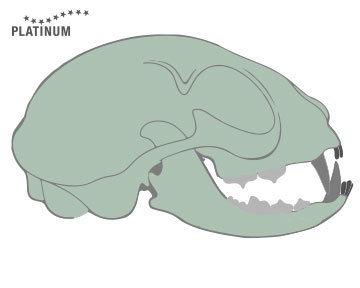 The anatomy of cat teeth
The anatomy of cat teeth
FORL - the most common dental disease
Dental diseases are unfortunately very common in cats. FORL, short for "Feline odontoclastic resorptive lesions", is the most common and also most painful dental disease in cats, in which the teeth slowly decay. Every third cat (regardless of breed, but especially Siamese and Persian cats) is affected - and from the age of five, every second cat. In FORL, the tooth including the root dissolves from the inside to the outside. The disease is probably caused by problems in calcium metabolism and calcium deficiency. In this process, the body's own cells activate so-called odontoclasts, which break down the dentin in order to mobilise calcium. An autoimmune reaction occurs in which the entire periodontium as well as the teeth are dissolved. In addition, FORL is caused by inflammation of the gums and by tartar. At the beginning, the disease is not painful and is also not visible to the naked eye. After the dissolution of the tooth root, nerves are exposed which cause great pain to the cat due to contact with saliva and germ flora.
There are three forms of FORL: Type 1 usually occurs together with plaque, tartar and inflammation of the gums. Type 2 can initially even develop without externally visible processes, such as inflammation. In this process, the tooth root is transformed into bone tissue and "fuses", so to speak, with the jawbone. Type 3 is a mixture of the first two forms.
Symptome of FORL in cats
If a cat falls ill with FORL, there are various symptoms. Cats with toothache may have problems chewing or avoid food altogether. Increased saliva production may also indicate pain. Head shaking or tilting the head so that only one side is loaded when chewing, as well as teeth grinding and chattering (so-called chattering) are also among the symptoms of FORL. As FORL progresses, the cat may also lose teeth that break off at the neck of the tooth. FORL type 1 also brings redness, inflammation and growths of the gums. If the cat is in particularly severe pain, this can also cause the cat to withdraw, become irritable or have problems playing.
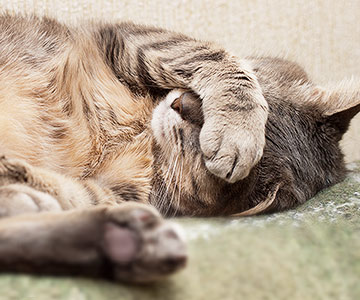 If cats have a particularly bad toothache, they may become withdrawn.
If cats have a particularly bad toothache, they may become withdrawn.
Diagnosing FORL in cats
If you notice symptoms of FORL, you need to consult a veterinarian. Preferably one that specialises in cat teeth, as appropriate equipment and specialist knowledge is required. If FORL is suspected, the cat's oral cavity is examined and probed for inflammation, growths, gum pockets, tartar or other changes in the teeth and gums. An X-ray of the dental apparatus is indispensable, as this is the only way to visualise dissolution of the root and the dental bone. Generally, a detailed examination as well as an X-ray can only be done when the cat is under anaesthesia. Ideally, such an examination should be carried out with every dental intervention in order to detect a change in the oral cavity at an early stage.
FORL treatment
Unfortunately, if a cat gets FORL, the dissolution of the dental bone cannot be stopped or reversed. The only possible form of treatment is surgical tooth removal to stop the inflammatory process and eliminate associated pain. Even with fewer teeth, a cat can live happily: the main thing is that the cat is pain-free.
Other dental diseases in cats
Besides FORL, there are also other dental diseases that can occur in cats. A distinction must be made between diseases of the teeth and diseases of the gums and periodontium. However, both structures are often affected.
Tartar formation
Tartar is one of the dental diseases that only affect the teeth. It is caused by the build-up of plaque, a sticky film consisting of bacteria, saliva and food debris. If plaque is not removed regularly, it mineralises and hardens. Tartar develops, which surrounds the teeth. Tartar itself does not cause inflammation in the cat's mouth, but the bacteria that get stuck on the rough tooth surface and irritate the gums do.
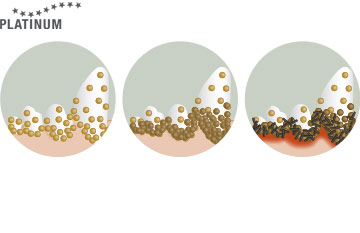 Tartar is caused by the build-up of plaque and can lead to inflammation.
Tartar is caused by the build-up of plaque and can lead to inflammation.
How much tartar is formed depends very much on the amount of saliva, as well as the position of the teeth or the bacterial flora in the cat's mouth. An unpleasant mouth odour (caused by tartar) can also develop in the cat.
Gingivitis/Stomatitis in cats
Healthy gums are pink, moist, smooth and shiny. Depending on the breed or coat colour, the gums may have dark patches or even be completely dark. If the gums are inflamed, you can recognise this by the red edge at the transition from tooth to gum. Inflammation of the gums (also called gingivitis) often occurs in conjunction with tartar formation. The gums will appear red, swollen and bleed easily - even when touched lightly. The angle of the jaw and the palatal arch are particularly affected. The tongue may also be fiery red and thickened. If the mucous membrane of the mouth is inflamed, it is called stomatitis. Both can be caused by poor oral hygiene. However, there are also chronic inflammations of the gums and mucous membranes, the exact causes of which are not known. Viral diseases, bacteria, genetic predispositions and autoimmune diseases probably play a role here.
Periodontitis in cats
Gum disease is often a precursor to periodontitis, a massive inflammation of the entire periodontium that can even lead to bone loss. In some cases, the cat may even lose its entire set of teeth. Much worse than the infection of the oral cavity are the bacteria and germs that enter the animal's bloodstream and cause damage to internal organs. If the germ load is increased, this can be life-threatening for a cat, as it has been proven that this can lead to inflammation of the internal organs, such as the heart, kidneys and liver, as well as to metabolic diseases.
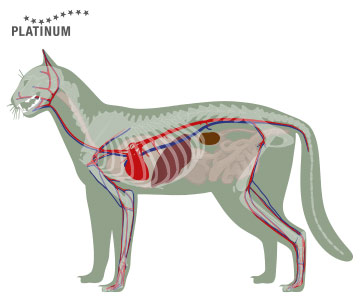 If the germ load is increased due to gum disease, inflammation of the internal organs can occur.
If the germ load is increased due to gum disease, inflammation of the internal organs can occur.
Treatment options for cats for dental diseases
No matter what dental disease a cat suffers from, the general rule is that the treatment of dental disease always depends on the severity of the condition. During a professional dental cleaning, the tartar can be removed by the vet under anaesthesia. In the case of particularly severe dental problems, affected teeth can even be removed to relieve pain and prevent infections. In some cases, antibiotics and painkillers are prescribed by the vet. Chronic diseases are usually not curable and must be treated permanently in consultation with the veterinarian in order to get them under control and to enable the cat to have a good quality of life. Moreover, preventive protection is also essential.
Preventing dental problems
Gingivitis and tartar in particular are not uncommon in cats and can have unpleasant consequences for your feline friend, which can limit their quality of life. That is why targeted dental care is important.
Regular checks
For indoor cats in particular, owners should attach great importance to dental care. Of course, the teeth of outdoor cats should also be inspected regularly. If a cat displays the first warning signs (bad breath and increased salivation) that indicate dental problems, their mouth should be examined. Brownish discolouration, solid plaque or reddened gums are reasons to visit the vet.
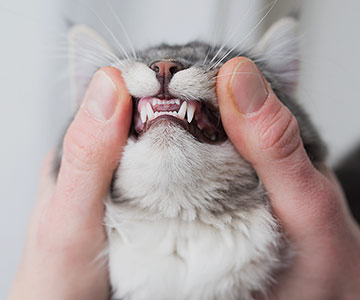 Regular check-ups help prevent many dental diseases.
Regular check-ups help prevent many dental diseases.
The right diet for cats
Adequate nutrition plays a crucial role in the dental health of cats. The right diet can help to ensure healthy teeth and gums in cats. Good cat food contains a high proportion of meat and few carbohydrates. It is also important to avoid sugar, as it is unnecessary in cat food. This way you can ensure optimal care for your cat.
Of course, cats should always have enough water available. The more a cat drinks, the less minerals will accumulate in the saliva. In combination with plaque, this creates tartar, which is difficult to remove, depending on the amount.
Regular check-ups with a vet
Visits to the vet round off the preventative approach. These should include dental health checks. This is the only way that dental problems can be detected and treated by experts at an early stage.
Frequently asked questions about dental diseases in cats
How do I know that my cat has dental problems?
If a cat suffers from loss of appetite, excessive salivation or reddened gums, these are all signals of dental problems. In addition, cats will no longer groom themselves properly and increasingly withdraw.
Where do dental problems in cats come from?
A cat's mouth contains many bacteria that are not normally pathogenic. Until they multiply. If there are more and more of them, they wrap around the teeth and create a soft, sticky coating. If this is not removed, it becomes hard. This is how tartar can develop. Tartar is the cause of most dental diseases in cats.
How do I recognise FORL in cats?
To recognise FORL, you should first look to see if you can recognise signs of toothache in general. In addition, cries of pain when eating and teeth grinding or chattering can be symptoms of FORL. A dental x-ray should be taken by the veterinarian for diagnosis.
What happens if FORL is not treated?
If FORL is not recognised or treated in time, a large part of the cat's teeth may become so damaged that they have to be removed. However, this is in the best interest of the cat! If a tooth that is affected by FORL remains, it causes pain. To avoid this, a cat may even stop eating.
Is FORL in cats curable?
FORL is an autoimmune reaction and therefore not curable. Teeth affected by FORL must be completely removed to relieve pain. FORL is not contagious.



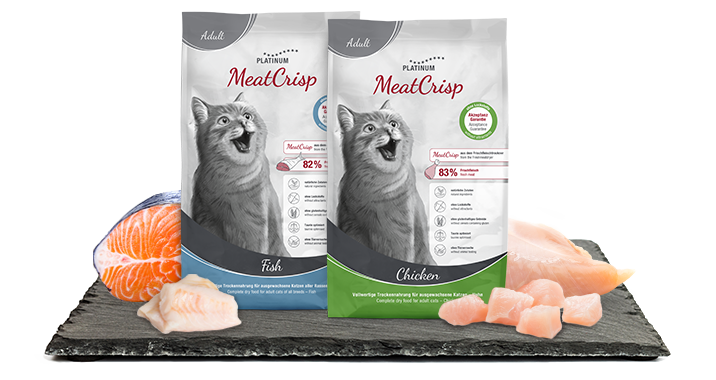
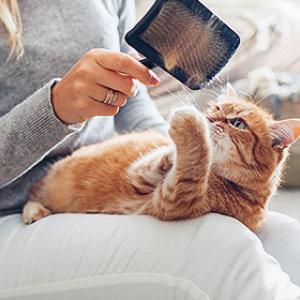
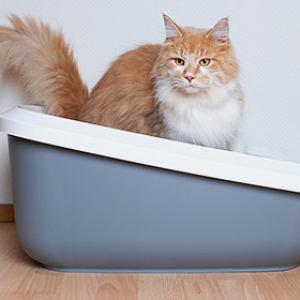
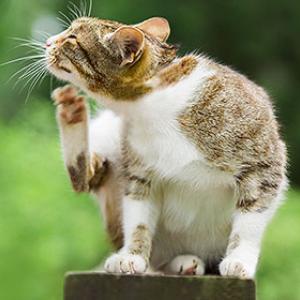
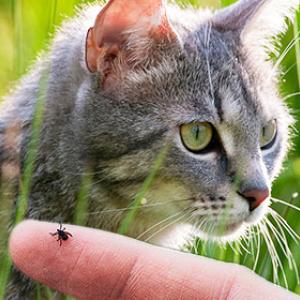
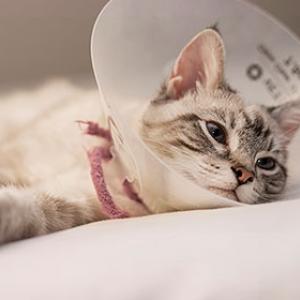
.png)
.png)
.png)